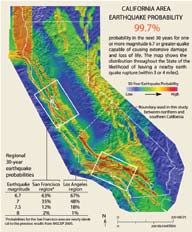
Conventional wisdom says that there's no such thing as a sure thing. Except for earthquakes in California.
A study released by the U.S. Geological Survey in April 2008 predicts that California has a 99.7 percent probability of experiencing a 6.7 magnitude earthquake sometime in the next 30 years.
Ray Weldon, professor of geology, is on the executive committee of the Working Group on California Earthquake Probabilities, a collection of scientists and engineers commissioned by the USGS to forecast the state's quake risk.
The team constructed the first-ever statewide map of earthquake probabilities throughout California -- the Uniform California Earthquake Rupture Forecast.
So which areas are most likely to get rocked? The Southern California section of the famous San Andreas Fault has a 59 percent probability of a 6.7 magnitude quake (or higher), while the Hayward-Rogers Creek Fault leads the way for Northern California at 31 percent.
The Pacific Northwest isn't out of the woods either. The Cascadia Subduction Zone spans about 150 miles of Northern California coastline, with another 600 miles stretching from the Oregon/California border to Vancouver, BC. That area experiences a magnitude 8 or 9 earthquake every 500 years or so, and the chance that one might happen in the next 30 is estimated at 10 percent.
The Working Group noted that earthquake probability is a fluid concept that can fluctuate over time due to the ever-changing condition of faults and stresses. Even in higher-probability areas, "the big one" might not happen for many decades, if at all.
- Amanda Miles



 Watch Darwin talks, read an essay by the "Weird Science" professor.
Watch Darwin talks, read an essay by the "Weird Science" professor.